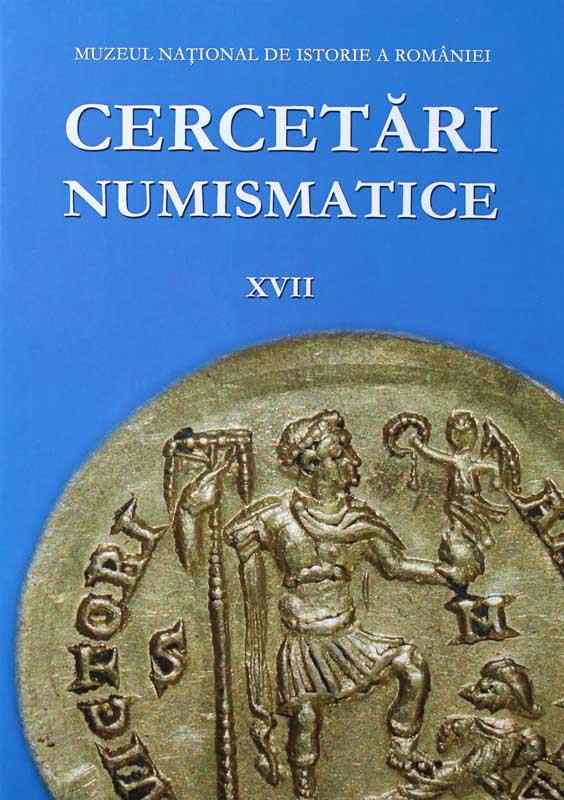
Câteva monede bizantine rare descoperite în Dobrogea şi problema influenţei bizantine în Balcani în secolul al VII-lea / A Few Rare Byzantine Coins Found in Dobrudja and the Extent of Byzantine Control in the Seventh-Century Balkans
| Autori |
|
| Secţiunea |
|
| Limba de redactare | română |
| Descriptori |
|
| Excerpt | This small collection was brought to our attention several years ago with the note that the coins had been found in Dobrudja (Romania) and collected due to their rarity. Although this is a plausible hypothesis in light of other finds from the region, no other information could be obtained. This is all the more regrettable as the coins in question are very rare finds not just in Dobrudja but also in the entire region of the Balkans. Even without much needed archaeological context such finds can still shed some light on the fate of the eastern Balkans during the seventh century, after the collapse of the Byzantine rule in the Danube region. The small group of coins includes a decanummium of Maurice, issued at Carthage in the second half of his reign (592-597) and initially attributed to a temporary mint at Constantine (Numidia). The decanummium issued at the beginning of Heraclius’ reign (610-612) and the half-follis of Constans II (652-657) were also struck by the mint of Carthage. The latest coin of the group is a half-follis of Constantine IV, issued at Constantinople in the last decade of his reign (674-685). Given the rarity of such coins it would be useful to undertake a brief survey of similar finds from the Balkans and to explore their significance in the broader historical context of the region. Indeed, the historical value of these finds is twofold. The first is chronological, as the coins are new additions to a very thin inventory of seventh-century coin finds in the Balkans. The second is geographical, most coins in the group being minted in North Africa, very far from the Eastern Balkans. This provides additional perspective on the circulation of goods and people across the Mediterranean world and its peripheral regions. As far as chronology is concerned the most interesting pieces are undoubtedly the coins dating to the second half of the seventh century, the half-folles of Constans II and Constantine IV. The decanummia of Maurice and Heraclius belong to the phase of coin circulation which began in 498 with the reform of Anastasius and lasted without any significant interruptions until the second decade of the seventh century when the monetary economy of the Balkans collapsed along with the Byzantine power in the region. Archaeological evidence from major Byzantine settlements in Dobrudja is unequivocal: the last phase of occupation ended during the reign of Heraclius and coin circulation ceased around 615. A certain degree of continuity has been noted on the Black Sea coast where a drastically reduced coin circulation carried on for another decade or so in important coastal settlements such as Tomis, Callatis, Mesembria and Agathopolis, although isolated finds are known from Danubian fortresses as well. Crushed by a taxing war with Persia followed by the almost immediate rise of Islam, Early Byzantium could not muster the strength and resources to maintain its positions on the Danube frontier. The Avars and the Slavs whose attacks had already damaged the frontier took control of the former provinces of the Balkans and played a major role in the failed siege of Constantinople in 626. During the brief respite between the final victory against Persia (628) and the decisive defeat at Yarmouk (636), which launched the Arab blitzkrieg in the Middle East, we witness a modest revival of the coin circulation. With the wealth gained after seizing the Persian royal treasury Heraclius even attempted a monetary reform meant to return the copper follis to the weight standard in use at the beginning of his reign. The measure was short lived and so was the infusion of fresh coin in the Balkans. Most of the recorded find spots are located on the Black Sea coast although gold hoards are known from the hinterland, such as the deposit found at Gorna Orjahovica in Moesia Secunda, as well as north of the Danube, at Udeşti in barbaricum. There are very few analogies in the Balkans for the half-folles of Constans II and Constantine IV. Stray finds without archaeological context have been reported in Scythia, at Constanţa, Isaccea, Mangalia and Silistra, as well as in the province of Moesia Secunda. The density of finds appears to be higher as one gets closer to Constantinople, if we judge by the the number of finds known further south at Mesembria on the Black Sea coast or in the provinces of Haemimons and Rhodope. There is insufficient evidence to reach a conclusion at this point but the overall contraction of the Byzantine monetary economy and the declining political reach are quite apparent. By this time, the influence of Constantinople and its monetary footprint extended mainly in the regions close to the city and on the Black Sea coast where the Byzantine fleet remained unchallenged until the creation of the Bulgar state. The fact that imperial propaganda continued to claim the Danube as legal frontier stands in sharp contrast with the actual state of its former provinces in the Balkans. At the same time, we should not ignore repeated Byzantine efforts to maintain some degree of influence in the region, although the dwindling resources of the empire could no longer support an ambitious political agenda like the one in place a century earlier. A few gold and silver coins as well as official seals testify to such efforts, whose numismatic traces can also be found across the Danube river in barbaricum. The region was still in contact with the Byzantine Empire, albeit much reduced compared to the sixth century when significant quantities of Byzantine coin flowed north of the Danube frontier. If bronze coins can be taken as evidence of communication and possibly trade in low-value items, not the same can be said about the large hoards of silver hexagrams, whose frequency is particularly high in the lands north of the Danube. They are a clear reflection of the empire’s diplomatic initiatives during this period of profound political and cultural transformation in the Lower Danube region. In the former provinces of the Balkans seventh-century emperors used not just diplomacy but also brute force to restore imperial control. The campaign ordered by Constans II against the Slavs in the 650s is well known and so are Constantine IV’s own attempts to stop the expansion of the Bulgars in the Balkans. Although both initiatives eventually failed to achieve their goal they did leave behind significant numismatic traces which help us better understand the balance of power in the region. The second unique feature of this small collection, as already mentioned, is the fact that three of the coins were issued by the mint of Carthage. Finds of coins produced by western Byzantine mints are very rare in the Balkans, where the local currency was supplied by the mints of Propontis - Constantinople, Nicomedia and Cyzicus, as well as Thessalonica, especially influent in the western part of the peninsula. The mint of Carthage had a more significant presence during the reign of Justinian I when the reconquest of North Africa and Italy reopened the Byzantine network of communication and exchange in the wider Mediterranean. Some coins ended up in the western Black Sea region, with further circulation being noted in the hinterland, as well as in the lands beyond the Danube frontier. Coins may have arrived with goods from the West, well documented in many Balkan settlements, or with troops transferred during the decades when the empire was engaged on several fronts at the same time. However, the combined proportion of coins struck by western mints accounts for less than two percent of all finds from Dobrudja. Paradoxically, the percentage is higher for the seventh century, but this does not reflect an intensification of contacts with the Mediterranean as much as being a direct consequence of the fact that mints such as Nicomedia and Cyzicus had been shut down during the reign of Heraclius. Only the mint of Constantinople supplied fresh coin with the modest contribution of mints from North Africa, Sicily and peninsular Italy. Furthermore, the Persian invasion, soon followed by the Arab conquest of the Eastern Mediterranean, must have seriously disrupted communication between east and west in the Byzantine world. We should not forget, however, the central role that Sicily gained in the second half of the seventh century, when Constans II abandoned his imperial residence in Constantinople and moved the capital to Syracuse. If the decanummia of Maurice and Heraclius may have arrived in Dobrudja before the dramatic events which marked the Mediterranean world in the seventh century, the half-follis of Constans II dates from the 650s when Byzantium had already lost all provinces in the Levant as well as Egypt. The presence of such a coin in Dobrudja betrays efforts to maintain a certain degree of communication in an increasingly fragmented Byzantine world. This hypothesis is strengthened by a larger inventory of seventh-century coins issued by North African mints. A hoard found in Constanţa (Tomis), published more than half a century ago, included coins from Heraclius to Constantine IV. Among them two dodecanummia and a piece of six nummia from Alexandria, a half-follis from Carthage and another one issued in Rome. We can assume that the coins arrived in Tomis by sea close to 680, which indicates that long-distance communication between the two regions had not been completely severed. To be sure, this is not a unique find, several other single finds being known, especially dodecanummia of Alexandria found at Constanţa, Mangalia and Silistra, on the Danube. The fact that the Danube region was still integrated in the larger network of communication and exchange is testified by finds from the lands north of the river. The most significant finds are the follis of Constans II from Carthage found at Novaci in Walachia and the coins from Carthage, Alexandria and Syracuse from the Obârşeni hoard in Moldavia, indicating that the empire’s connection to the world north of the Danube went beyond the level of diplomatic contacts reflected in the contemporary hoards of silver hexagrams found in the region. In conclusion, this small collection adds precious data to the small dossier of seventh-century coin finds in the Balkans and helps clarify some aspects related to the history of the region during a dark period of cultural, political, and economic transformation which marks the transition from antiquity to the Middle Ages. |
| Paginaţia | 53-64 |
| Descarcă fişierul | |
| Titlul volumului de apariție | |
| Editura | Publicat de: Muzeul Naţional de Istorie a României |
| Loc publicare | Bucureşti |


